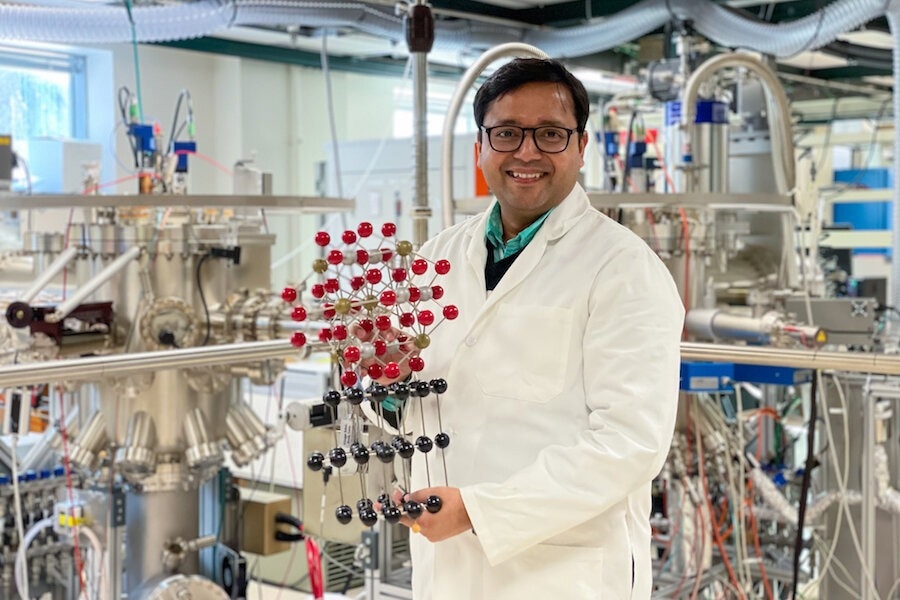The epitaxy of functional oxides on a graphene-coated substrate is preferred for enhancing structural qualities and generating freestanding epitaxial nanoscale membranes for scientific research, applications, and cost-effective substrate repurposing.

University of Minnesota Twin Cities Professor Bharat Jalan is co-leading a team that has developed a new method for making nano-membranes of “smart” materials, which will allow scientists to harness their unique properties for use in devices such as sensors and flexible electronics. Credit: Olivia Hultgren
However, graphene may be damaged by the severe oxidizing conditions commonly utilized to form epitaxial oxides.
In a paper published in the journal Science Advances, a team from the University of Minnesota showcased the effective utilization of hybrid molecular beam epitaxy (MBE) for growing strontium titanate (SrTiO3) without damaging the graphene substrate.
Limitations of Conventional Epitaxy
The epilayer is tightly attached to the substrate in conventional epitaxial growth, limiting the reusability of the costly single-crystal substrate unless the coating is removed by polishing.
Permanent attachment of the film to the substrate can make it difficult to characterize the film since substrate signals are sometimes several orders of magnitude greater than the film signals.
Developing simple methods to generate freestanding single-crystal nanoscale membranes is of high economic and scientific significance as a result.
Existing Methods of Producing Freestanding Nanomembranes
The most basic method is to reduce the thickness of bulk wafers to microscopic levels through grinding or etching thicknesses. Still, this method lacks accuracy and offers poor material efficiency as most of the wafer is discarded.
A more accurate process employs a sacrificial layer between the film and substrate. When removed, this sacrificial layer liberates the thin film as a standalone membrane. For removing the sacrificial layer, heat or selective etching may be used.
Using a sacrificial layer has the benefit of potentially recycling costly substrates and possesses the same level of accuracy as the used thin-film growth process.
Using an interface having weak adhesive qualities, like singular or multiple van der Waals (VdW) materials, is another method for producing freestanding single-crystalline membranes.
Using a VdW material is an established strategy for obtaining standalone single-crystalline membranes with the benefits of increased material efficiency. This is because a sacrificial layer is unnecessary, and there is the capability to produce thin films with higher crystal content than those produced with conventional epitaxial growth.
Advances in Molecular Beam Epitaxy of Perovskite Oxides
With the chemical adaptability and functional versatility of perovskite oxides, it is desirable to extend distant epitaxial growth to perovskite oxides to possibly increase structural qualities and explore freestanding membranes.
Oxide MBE is a modular and adjustable low-energy deposition method employed to create a variety of perovskite oxides. Typical oxide MBE utilizes effusion cells to cause the sublimation or evaporation of metals and metallic suboxides together with a source of oxygen for oxidizing metals at the epitaxial growth front.
The highly aggressive oxygen sources can break down graphene, thus, molecular oxygen given at a small background pressure has been used as a milder oxygen source for distant epitaxial growth of oxides. However, nanoscale membranes of complex oxides having self-regulatory stoichiometry have not been grown before.
Hybrid Molecular Beam Epitaxy
Hybrid MBE overcomes these issues by substituting elemental Ti with titanium tetraisopropoxide (TTIP) as the metal-organic source.
The elevated vapor pressure of titanium tetraisopropoxide or its decomposed intermediates offers a desorption technique that self-regulates the stoichiometry of Sr:Ti cation and provides an epitaxial growth window in which the integrated Sr:Ti ratio is unity and resistant to flux instabilities.
Important Findings of the Study
In this paper, the team showed a unique hybrid MBE technique for producing epitaxial layers of SrTiO3 on graphene utilizing TTIP and Sr sources without including an oxygen source.
Within the growing window, the approach created films with self-regulated cation stoichiometry and atomic thickness control. The films are capable of being exfoliated as membranes and transferred to different substrates.
This research has paved the way for a vast array of experiments on standalone oxide membranes with the advantages of hybrid MBE.
Future research could study how to improve the quality of such films using in-situ-grown or dry-transferred graphene and explore a broad range of material systems and heterostructures.
A Word from the Researchers
Dr. Bharat Jalan, a Senior Author of the paper said, "We showed for the first time, and conclusively by doing several experiments, that we have a new method which allows us to make complex oxide while ensuring that graphene is not oxidized. That's a major milestone in synthesis science."
We now have a way to make these complex oxide membranes with an automatic stoichiometric control. No one has been able to do that.
Dr. Bharat Jalan, Senior Author, Department of Chemical Engineering and Materials Science, University of Minnesota
Reference
Yoon, H., Truttmann, T. K. et al. (2022). Freestanding epitaxial SrTiO3 nanomembranes via remote epitaxy using hybrid molecular beam epitaxy. Science Advances, 8(51). Available at: https://doi.org/10.1126/sciadv.add5328
Disclaimer: The views expressed here are those of the author expressed in their private capacity and do not necessarily represent the views of AZoM.com Limited T/A AZoNetwork the owner and operator of this website. This disclaimer forms part of the Terms and conditions of use of this website.